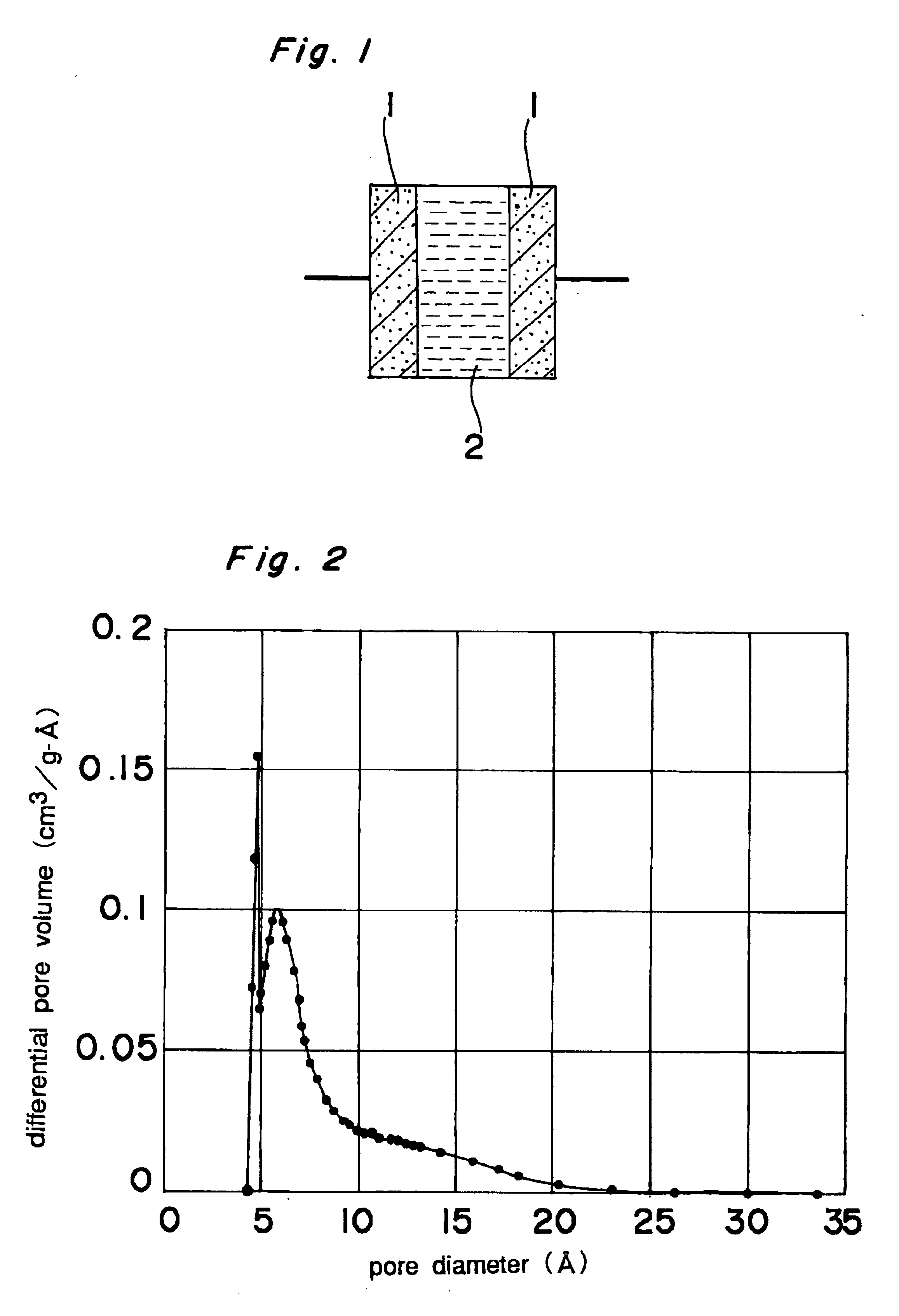Solid activated carbon, process for manufacturing the same and electric double layer capacitor using the same
- Summary
- Abstract
- Description
- Claims
- Application Information
AI Technical Summary
Problems solved by technology
Method used
Image
Examples
example 1
First, to 100 parts by weight of a coconut husk-type activated carbon powder having a BET value of 2,000 m.sup.2 / g were added PVB and mesophase in the proportions shown in Table 2 to prepare various compositions. Each composition was stirred using a high speed mixing stirrer to prepare powder, which was successively screened using a 40 mesh screen to produce a molding raw material.
Next, the molding raw material was molded by press molding or roll molding to prepare a plate molded compact.
The molded compact was treated by aging in air in the conditions of temperature and holding time as shown in Table 2 and was then calcined in vacuum at the temperature shown in Table 2 to carburize PVB and mesophase and to produce an activated carbon substrate for evaluation which is a complex of activated carbon and carbon, having a size of 70 mm length, 50 mm width and 1 mm thickness.
For comparative examples, activated carbon substrates were prepared using an acryl-type resin in place of PVB in t...
example 2
Activated carbon powder (husk-type, BET value: 2,000 m.sup.2 / g) and PVB were formulated in the proportions shown in Table 4 to prepare various compositions. Each composition was stirred using a high speed mixing stirrer to prepare a powder, which was allowed to pass through a 40 mesh screen to produce a molding raw material.
The specific surface area of the above activated carbon powder is preferably in a range from 1,500 m.sup.2 / g to 2,500 m.sup.2 / g for use as the electrode 1 of the simplified double layer capacitor though it may be determined according to the objective capacitance and there are no limitations to it. In addition, though any polyvinyl butyral may be used as the above polyvinyl butyral (PVB), if it is commercially available, those having a polymerization degree of 1,500 or less are desirable since a polymerization degree exceeding 1,500 impairs the molding characteristics during dry molding.
The resulting powder was molded by dry press molding or dry roll molding to...
example 3
Activated carbon powder (husk-type, BET value: 2,000 m.sup.2 / g), PVB, and mesophase carbon were formulated in the proportions shown in Tables 5-11 to prepare various compositions. Each composition was stirred using a high speed mixing stirrer to prepare a powder, which was allowed to pass through a 40 mesh screen to produce a molding raw material.
The specific surface area of the above activated carbon powder is preferably in a range from 1,500 m.sup.2 / g to 2,500 m.sup.2 / g for use as the electrode 1 of the simplified double layer capacitor though it may be determined according to the objective capacitance and there are no limitations to it. In addition, though any PVB may be used as the above PVB, if it is commercially available, those having a polymerization degree of 1,500 or less are desirable since a polymerization degree exceeding 1,500 impairs the molding characteristics during dry molding.
The resulting powder was molded by dry press molding or dry roll molding to prepare a ...
PUM
 Login to View More
Login to View More Abstract
Description
Claims
Application Information
 Login to View More
Login to View More - R&D
- Intellectual Property
- Life Sciences
- Materials
- Tech Scout
- Unparalleled Data Quality
- Higher Quality Content
- 60% Fewer Hallucinations
Browse by: Latest US Patents, China's latest patents, Technical Efficacy Thesaurus, Application Domain, Technology Topic, Popular Technical Reports.
© 2025 PatSnap. All rights reserved.Legal|Privacy policy|Modern Slavery Act Transparency Statement|Sitemap|About US| Contact US: help@patsnap.com

